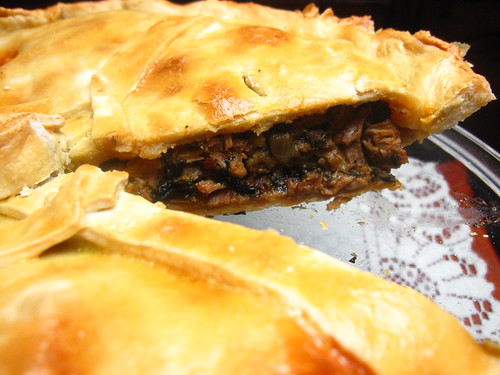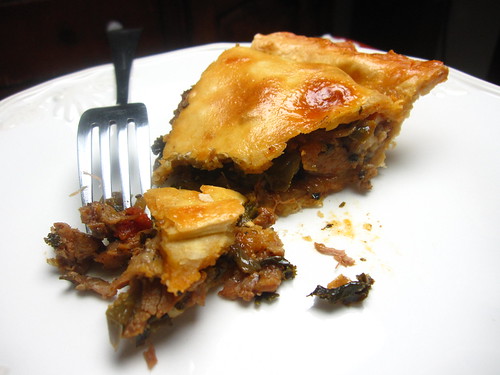Being the innate pessimist that I am, watching a small boat being knocked around like a dodgem car on the rollicking, blue-grey seas at the normally placid Jersey Shore this past weekend put me in mind of the Costa de Muerte, the coast of death, on Spain’s north-west coast, where Galician fisherman have taken their lives in their hands for generations. [In a quirk of editorial fate, I may, unwittingly, have taken inspiration for this flight of fancy from the cover (then unopened) of this month’s Bon Appetit, but as you will see, if you persevere, there is a mite more detail below than Barbara Fairchild typically provides.]
The ocean’s bounty has never been translated into material riches in that part of Spain, and even in modern times, in spite of renewed interest centered around its albariño and mencia wines, artisanal cheeses, and gooseneck barnacles, it remains comparatively impoverished. Consequently, Gallegos have, for generations, cast their fortunes in the wind and sought better lives for themselves in other parts of Spain and the New World, including Brazil, Uruguay, Venezuela, Argentina, and Cuba.
Interestingly, and this is mostly unrelated, during researching this post, I learned that Fidel Castro’s father was one such Galician emigrant. His mother was also of Galician descent. In fact, Castro is a common Galician family name that is derived from the circular stone-built houses or “castles” of the Castreña — the Celtic Bronze Age culture that left a number of characteristic walled villages across the region. [Ironically, of course, Galician heritage is perhaps the only thing that the communist Fidel shared with his fascist counterpart Francisco Franco, but it was enough for the former to take up an invitation from the-then leader of Spain to visit their shared “home” region in the 1960s.]
The late 19th century marked the beginning of mass Galician emigration to the New World, and an unknown, but significant, number of Gallegos emigrated to Argentina and Uruguay during this period. Today, the two New World cities with the greatest number of people of Galician descent are those countries’ respective capitals, Buenos Aires and Montevideo, so much so, that it is not uncommon for Porteños to refer to all Spaniards as “Gallegos”.
Regular visitors to this blog will, perhaps, recall last April’s post about Argentine pizza which ventured a sociological theory on the impact Italian immigrants have had on the culture and food of their adopted country. It is just possible that I overstated things a little. You see, beyond its magnificent meats, Argentinian cuisine’s next most famous item is not, as I said, its pizza or pasta, but its empanadas. To explain this, I had originally intended to embark on a lengthy discussion of how Galician immigrants were behind the development of the iconic Argentine empanada. Sadly, I could find no evidence whatsoever to support this hypothesis, especially since Argentine empanadas resemble more closely the typical Spanish empanadilla than the much larger Galician empanada, and were likely to have been popular in Argentina long before Gallegos arrived en masse. Instead, a brief description of how we came across Galician empanadas in a veritable sea of Argentine-style pies during our stay in Buenos Aires last year will have to suffice. Sorry about that.
We snacked almost constantly on empanadas with a variety of fillings throughout our ten days in Buenos Aires, and began taking their quality and ubiquity mostly for granted. It was only later on in our visit when we came across Pizzeria la Americana (aka La Reina de las Empanadas), an established bakery and cafe a block from the Palacio del Congreso de Argentina, that we realized not all empanadas are created equal. In this giant place that takes up most of a city block, a bevvy of savory pastries, large and small, sat glowing warmly under spotlights behind glass screens. These piles of regular small empanadas beckoned, crustily, at us, and we would have reverted to habit and ordered a slew of them had we not spied some giant pies on individual cake stands next to them. We hadn’t seen anything like these before — two or more inches thick, baked to a shiny golden patina and filled with, among other things, greens, boiled eggs and ham — yet they were also described as empanadas. What were they?
Even more confusingly, one of the large ones was labelled “pascualina”, a moniker for pies we had come across only once before, and then in Genoa, to describe that city’s special Easter variation of the spinach/chard and ricotta torta de bietole. Could these pies be variations on that? We weren’t sure, and couldn’t summon enough of our tourist Spanish to ask what might turn into something of a lengthy and garbled question about nomenclature, semantics and gastronomic anthrolopology.
Argentina’s ethnic mix has contributed to a unique South American melding of Iberian and Italic culture and cuisine, in which a pizzeria could quite legitimately describe itself as the queen of the empanada, while simultaneously serving Genoese-influenced Galician specialties without breaking stride or encouraging skepticism from potential customers. We were momentarily confused by it all, but decided there was nothing to do but roll with it, and so ordered a couple of giant slices of the empanada Gallega de pollo, which turned out to be a delicious, if over-generous, appetizer for our subsequent lunch at one of the city’s oldest Italian restaurants.
Neither of us had ever had a pie quite like this before. It didn’t really resemble the free-form tuna and sardine empanadas I’d tried in Santiago de Compostela and Vigo years ago, nor was it like an American-style pot pie we’re so familiar with, brimming with sauce and chunky vegetables. With a bready, pizza-like crust, top and bottom, and baked in a dish about the same dimensions as a deep-pan pizza, the filling was a moist and peppery combination of chicken, sauted greens, onions and red pepper. It was absolutely delicious and we have both been raving about it ever since, but everytime we’ve tried to make any of the many variations on Galician empanadas, we’ve failed to produce anything similar, nor have any recipes for Argentine empanadas worked out the right way.
In truth, the, what I’m going to call, Argentine-style empanada Gallega that we did make, wasn’t quite as good as the one we ate in Buenos Aires. The dough was too firm, not bready enough, and I should have tried using a modified pizza dough instead, but the filling more than made up for its shortcomings. In place of chicken, we slow-roasted half a Long Island duck that we had left over in the freezer from the hand-rolled Tuscan pasta with duck ragu and mixed it with sauted kale, green pepper, garlic, smoked paprika (pimenton) and lots of onions.
Experimentation on this front will continue because I could usefully spend some more time beautifying my rather scruffy attempt at a decoration, but also because one empanada fed the both of us for dinner that night and for lunch three subsequent days, and it just got better with each passing meal. Feel free to mess around with the dough recipe to your heart’s content, just as we will when we make this again, and, of course, the filling is entirely up to you too. Duck is kind of a luxury, and chicken, tuna, sardines, boiled eggs, a variety of vegetables, or plain old ground beef, would be absolutely fine. You should also feel free, should you feel geeky enough, to develop your own specious theories about the development of various global cuisines. They probably won’t be any less likely than mine.
Ingredients:
For the dough
- 500g (18oz) plain flour, sifted
- 1 teaspoon kosher salt
- 1 tablespoon white wine
- 2 tablespoons olive oil
- 4-6 tablespoons cold water
- 1-2 tablespoons butter
- 2 eggs, beaten
For the filling
- 1/2 Long Island (or other) duck
- 2 large onions, diced
- 1 green bell pepper, diced
- 6-8 cloves garlic, minced
- 1/2 bunch (about 2 cups) kale, shredded
- 1.5 teaspoons smoked paprika
- 1.5 teaspoons freshly ground black pepper
- 1/2 glass white wine
- 1 bay leaf
- (optional) 1/2 teaspoon dried thyme or sage
- kosher salt
Recipe:
For the dough:
- Sift flour and salt together
- Add wine and oil, and half the water
- Combine with your hands or in a food processor, adding additional water as necessary, until you have a reasonably moist ball of dough.
- Wrap this in plastic and allow to rest for half an hour
- Turn out dough on a floured board and, cut it in half.
- Roll out first half to a thickness of about 1/2inch (1cm)
- Take a deep pie pan (we used a large tagine) and rub bottom and sides well with butter
- Carefully place rolled-out pastry in the bottom and push into place until it lines the bottom and sides
- Add filling (see below)
- Roll out second half of dough to roughly the same thickness, possibly leave it a bit thicker
- And carefully place this on top filling. Press bottom and top together with your fingers and a little water to fix them together.
- Use leftover dough to make any designs you like on the top. Hopefully, they’ll be better than mine.
- Make a couple of holes for steam in the pie crust, and brush evenly with beaten eggs.
- Place in a 400F oven for about 40 minutes or until golden brown.
- Remove and allow to cool before serving
For the filling:
- Preheat oven to 400F.
- Place in oven and cook for 40minutes
- Reduce heat to 275F and cook for another hour and a half.
- Remove bird and allow to cool thoroughly.
- In the meantime, saute onions, green pepper, garlic and kale in olive oil until all wilted and soft.
- Season with paprika, black pepper, salt and bay.
- Add white wine, cover and cook for another 15 minutes
- When duck is cool, strip all the flesh off the carcass, discarding the skin (or reserving it for something else delicious)
- Pull or chop duck meat into small pieces and add to vegetable mixture.
- Stir well and cook for five minutes
- Remove bay leaf and check filling for seasoning. Adjust accordingly.
- Allow to cool, then follow directions from Step 9 onwards above.
Season duck or duck pieces well with salt and pepper, and rub with olive oil.
La Reina de las Empanadas
Avenida Callao, (esq. Bartolome Mitre),
Buenos Aires, Argentina‎
T: (0)11 4371 0202
W: pizzerialaamericana.com.ar
‎






Indeed empanada is one of my favourite foods… superb!
I’ve been missing you queridos! Your empanada looks like a work of art!!! Deliciosa and jugosa :D.
Jonny… maybe you are a pesimist… but what you surely are is an erudite :D. Thanks for all the info.
@Núria – gracias! Siendo un inmigrante mismo, la historia de la inmigración me fascino y qué inmigrantes toman con ellos.
@Miriam – empanadas may well be one of the world’s greatest things.
Brilliant article and detective work… I look forward to trying this recipe and variations… nothing like a hand pie for ease of eating!
Do you think you could classify the empandada in the 5th picture as being a form of sandwich?
@Jonathan – i can completely see what you mean, and if pies, in general, can be said to be baked sandwiches, then, sure, why not? I think that picture looks most like a sandwich because the dough resembles bread, but it was cut from a giant circular pie, rather like a wider, flatter Melton Mowbray pork pie (minus the aspic of course).
We know very little about Galician-style empanadas through the _Culinaria Spain_ cookbook. We even made them for our New Year’s Eve party! We totally made up the filling, though; don’t know if the filling is in any way traditional.
I really love that this empanada is in pie form…it seems so much more satisfying to me that way! And the filling sounds delicious.
Spectacular post and artistry with your Empanada Gallega. Of course, I’m prejudiced because my maternal grandparents were from Galicia though they settled in the lower East Side of NY. And I’m an Argentine-phile so I got a double treat. The empanada my family makes is with bacalao, shrimp, peppers + onions.
P.S. I’m going to BA early Oct and I’m putting this pizzeria on my list. I’ll also be getting in touch with you by email for any other tips. OK?
Duck empanadas?! I just don’t see any way that that couldn’t be mind-blowingly delicious! Thanks for the history lesson, it’s one of my favourite things about visiting.
Ducks from Long Island must be at treat. 🙂 Thanks for sharing this. A lot of cultures share a sort of hand pie, but this one may literally be just that. Love how on-the-go it can be.
Duck empanada??OHMYGOD! The jersey shore needs it yum!
This duck empanada is delicious! I would love to make it some day.
You always have my attention when you use duck! What a great idea for an empanada filling.
Your post is so informative and interesting. What a trip through Spain and Argentina! I was also interested in the empanada itself. I rarely ever see empanadas as a whole pie. I always think of them as hand pies. My sister-in-law, who is Colombian makes empanadas were the dough is made from yucca root and isn’t really firm. Her empanadas are more like tamales. She only ever makes them with beef or chicken. I wonder what I could do to get her to make them with duck. 😉
Spectacular empanada! That crust is just gorgeous and nice touch with the flower on top. Bravo!
You guys are lucky; since you’re both in on this blog thing, you obviously understand the need for multiple photos from many angles. Me, I’m all alone, and it’s all I can do to get off a decent shot before dinner vanishes into my family’s ravening maws.
Will there be a quiz in the next post?
This looks absolutely wonderful!
duck empanada…yum!
Oh My Goodness! That looks amazing. I’ve never had a filling of duck in an empanada.
I have learned something today… and drooled all over my keyboard. I didn’t realize those things were on my to-do list, but I feel as though I have accomplished something. 🙂
such a creative idea- duck. and i always love reading about the historical background of a dish in your posts. x shayma
wonderful – looks sooo good!